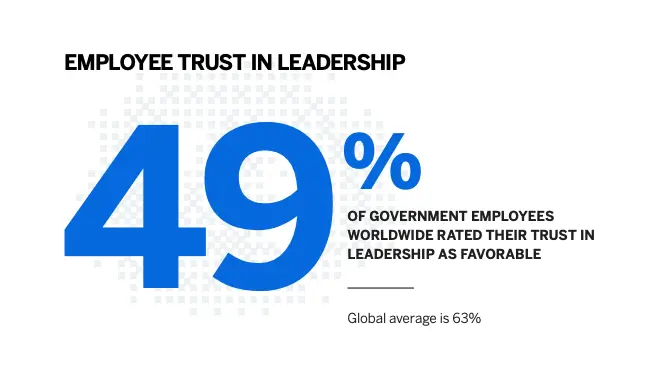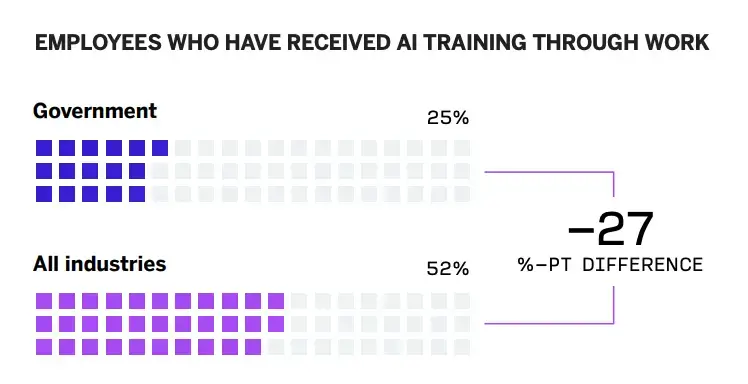Author: Adam Bunker
Subject Matter Expert: Haley Gust
Improving customer experience in government agencies directly impacts trust, accountability, and civic engagement. By focusing on user research, human-centered design, and digital transformation, agencies can become more effective and responsive when interacting with residents and businesses alike.
What is government customer experience (CX)?
In the government sector, customer experience refers to the successes and failures in how residents and businesses interact with a wide range of government services.
Generally, good government customer experience means nailing several key concepts:
- Service accessibility
- Information clarity and availability
- Wait times and responsiveness
- Communication quality
- Consistency across different touchpoints
The term ‘customer’ may seem confusing at first. After all, who exactly are a government’s customers?
In this context, a customer is any person or entity that uses one of the government’s many wide-reaching services. So that might be a citizen filing their taxes, a business that requires federal permits, or visitors who interact with immigration and tourism services.
The key difference between government customers and those in the private sector is that the former often have no choice but to use these services. When applying for a driver’s license, for example, there’s no alternative option available.
Increasingly though, the private sector’s longstanding focus on improving customer experience is being used as a blueprint for the kind of service delivery people also expect from the government. That means customer satisfaction, digital transformation and user-centricity are becoming ever-higher priorities for government agencies – rather than simply focusing on minimum service viability.
Free eBook: 2025 Government Trends Report
Why customer experience is so important
In the private sector, customer experience is everything. It’s often the key driving factor behind purchase decision-making, and excellent customer experience is what turns one-time buyers into lifelong loyalists:
- CX Index reports that customer-centric brands enjoy 60% higher profits than those not focusing on CX.
- PWC research suggests that 73% of customers cite CX as their top decision-making driver, and 86% are willing to pay more for top tier experiences.
- Analyst Esteban Kolsky suggests that 72% of customers tend to share a positive experience with six or more people.
- Our own XM Institute research shows that consumer satisfaction hugely impacts key loyalty behaviors.
Even though the customers in government services don’t have the same kind of choice as with B2C or B2B products, the same principles apply: enhance customer experience, and you’ll improve related metrics and core characteristics, including…
Trust and accountability
When government services are efficient, fair, and easy to use, citizens and partners develop greater trust in public institutions. Poor experiences, on the other hand, can undermine people’s confidence in the government’s ability to function.
Efficiency and cost savings
Well-designed, user-centric services with clear processes often reduce errors, repetition, and unnecessary steps. That saves people and agencies time and resources, which helps reduce the cost to serve.
Democratic participation
Positive interactions with government services can help encourage civic engagement and participation, which has positive knock-on effects in directing services toward areas of public need.
Ultimately, government services are paid for by tax dollars, so people have a natural expectation that the government can deliver positive experiences through human-centered design and processes.
Government experience trends
All of this invites us to consider: is the government meeting the expectations outlined above? Government customer experience is an ever-changing landscape – balancing financial and staffing challenges with ongoing digital transformation and shifting expectations.
To gauge where taxpayer investments are paying dividends, Qualtrics partnered with Code for America to benchmark the state of customer experience across a range of state services – including motor vehicles, state taxes, Medicaid, and SNAP.
In general, CX in government must universally navigate a complex set of challenges and trends:
Trust issues
Public trust in government is often lower than in other sectors. As of April 2024, just 22% of Americans said they trust the government ‘to do what is right’. Our own research showed that just 49% of government employees worldwide rated their trust in leadership as favorable.

Customer satisfaction challenges
Low satisfaction ratings are common for the sector. Customer experience has often been secondary to other priorities when compared to its place at the heart of private sector business practices.
Employee engagement stagnation
When government employees feel less engaged, there’s a need for better support and ongoing empowerment initiatives that can help improve service quality.
Slow tech adoption
Governments tend to be slower to adopt pioneering new tools like artificial intelligence. Slow digital transformation means missed opportunities to improve services – while also boosting productivity and efficiencies.
Feedback inefficiencies
Many governments lag behind when it comes to gathering and acting on employee and customer feedback. This is a hugely important part of service delivery improvement, so government agencies must work on better incorporating feedback loops into planning and process development.
More specifically, our research pinpoints three key government experience trends for 2025:
- Trust
- Resilience
- Productivity
To find out how to take a proactive approach to tackling each key trend – and where to go next – download our free eBook: Qualtrics 2025 Government Experience Trends Report.
Government experience management strategies
Transforming government customer experience hinges on getting the fundamentals right, building with future-proof processes in mind, and thinking with a people-first mindset. Here are six customer experience strategies that agencies can use to bolster customer satisfaction:
1. Learn how employee experience impacts customers
Customer experience and service delivery can’t improve if the people behind those services aren’t engaged and empowered. Employee experience (EX) is a vital building block for better customer experience because staff who feel valued often provide a better quality of service, are less stretched, and feel inclined to bring their best to the table.
Government teams can improve employee experience by using the right software. Truly comprehensive EX tools can manage and automate onboarding, training, and ongoing employee feedback in a way that flags actionable insight – and demonstrates clear ROI.
2. Focus on omnichannel customer experience
One of the most central pillars of great customer experience is consistency. In a government setting, people expect seamless journeys and processes, no matter the platform. Omnichannel CX means working to bridge divides between channels and touchpoints, and services.
But omnichannel CX is also about listening. That means being able to scoop up feedback from calls, emails, texts, user behavior and social media posts, and turn all that information into insights that can help close experience gaps. Again, the right software can help: look for omnichannel CX software that’s able to connect data points from every platform.
3. Put customer feedback to work
Customer feedback is a goldmine of valuable information, but that’s only the case if it’s used to improve service delivery. The ability to turn trends and customer sentiment into action relies on being able to solicit and gather information at scale, using tools like natural language processing to uncover a consensus from typically disparate sources.
In practice, this means using experience management software to capture feedback, analyze what’s gathered, and turn it into actionable next-steps.
4. Build human-centric journeys
Being human-centric means understanding what customers are trying to achieve in any given interaction, and designing flows that meet those needs. Government customer experience gains happen when teams track user behavior, conduct journey mapping, and utilize user research tools like session replay and heatmaps.
The outcome should be government services reflecting human-centered design, where processes and services are engineered specifically for proven user journeys.
5. Unlock the power of AI and automation
AI-enabled tools can take a lot of the work out of achieving some of the competencies we’ve already mentioned. AI can help automate services where customers choose to self-serve. It can monitor and understand customer interactions from across touchpoints. It can work on time-consuming tasks that free humans up to do more complex work. And it can glean insights from all of the above to help make changes that enhance the customer experience.
Digital transformation is a hot topic in government service delivery because state, local, and federal agencies typically lag behind the private sector when upgrading their tech stack. Only 25% of government employees globally have received AI training through work compared to 52% in all industries.

But modern customer experience excellence is only enabled via interconnected tools and digital services that use AI and other cutting-edge technologies from top to bottom. That’s how businesses and government agencies alike can deliver services that people expect – and that foster customer satisfaction.
6. Break down departmental silos
In government, customer needs rarely stay within a single department or service. Citizens will use dozens of government services throughout their lifetime – often repeatedly – so it pays to be able to use insight from those interactions to help improve customer experience on a unilateral basis.
Data ecosystems (where crucial data and insights are shared across departments and between partners) can help the government unify experiences and deliver services that feel more connected. While user privacy regulations and safeguards need to be met, bridging data silos can lead to more personalized, connected digital experiences.
How Qualtrics can help
The Qualtrics Experience Management Platform™ allows government teams to collect and analyze experience data, combining it with operational data to unlock decision-making insights that can better serve the public.
Our tools enable a holistic, top-to-bottom understanding of what’s working and what needs attention across a wealth of government services. That’s alongside actionable next steps for improving customer experience across in-person and digital services.
Hundreds of government agencies use Qualtrics tools; we help businesses, departments and teams improve service delivery, increase employee engagement, and deliver significant cost savings.
In 2025, that kind of data-driven knowledge has never been more important for government service delivery. Our 2025 Government Experience Trends Report highlights three key trends affecting government experience management:
- Trust
- Resilience
- Productivity
To find out how those trends are affecting agencies and service delivery internationally, and how to capitalize on our insight, download our free eBook below.
Free eBook: 2025 Government Trends Report